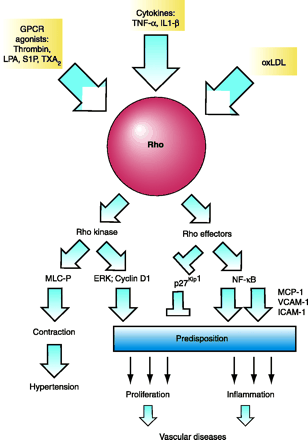
- Institution: Stanford Univ Med Ctr Lane Med Lib/Periodical Dept/Rm L109
- Sign In as Member / Individual
RHO SIGNALING in Vascular Diseases

Rho signaling in vascular diseases. The upregulation of vascular RhoA, observed in hypertentsion, is hypothesized to enhance VSMC proliferation and inflammation in response to injury and atherogenesis. Inflammatory mediators including GPCR agonists, cytokines, and oxidatively modified LDL (oxLDL) signal through Rho to produce a variety of cellular responses involved in cell contraction, proliferation, and inflammation. These Rho-mediated responses contribute to the development of vascular diseases. Rho acting through Rho kinase has also been suggested to produce LIM kinase– and stress fiber–dependent activation of ERK, which in turn regulates the timing of cyclin D1 expression and cell cycle progression. It is likely that inflammatory mediators signal through Rho to activate NF-κB, increasing the expression of monocyte chemotactic peptide 1 (MCP-1), and adhesion molecules such as VCAM-1 and ICAM-1, leading to recruitment and adhesion of monocytes to the vascular wall. All of the signaling components mentioned above predispose to vascular disease.


